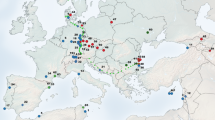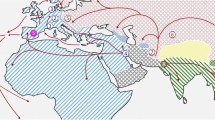Abstract
Mus musculus domesticus, M.m. bactrianus, M. m. musculus, M.m. castaneus, and M.m. molossinus wild mice were investigated for polymorphisms of the Y Chromosome (Chr) genes Zinc finger-Y (Zfy) and Sex-determining region-Y (Sry). Zfy divided the Y Chrs of these mice into domesticus- (domesticus) and musculus-types (musculus, castaneus, molossinus). M.m. bactrianus specimens had both Y Chrs, possibly owing to the introgression of a musculus-type Y into this population. Sry identified a subpopulation of musculus-type Y chromosomes. This subpopulation, designated the molossinus-type, was found in M.m. molossinus, a M. musculus subspecies specimen from northern China (Changchun), and laboratory mice. The cumulative data suggest that M.m. musculus of northern China and Korea are subpopulation distinct from M.m. musculus of Europe and central China and that this subpopulation invaded Japan, giving rise to M.m. molossinus. Furthermore, the data suggest that the musculus-type Y of the laboratory mouse originated from this subpopulation, corroborating early historical record reporting that Chinese and Japanese mice that were imported into Europe for the pet trade contributed to the genome of the laboratory mouse.
Similar content being viewed by others

References
Ashworth, A., Skene, B., Swift, S., Lovell-Badge, R.: Zfa is an expressed retroposon derived from an alternative transcript of the Zfx gene. EMBO J 9: 1529–1534, 1990.
Auffray, J.-C., Marshall, J.T., Thaler, L., and Bonhomme, F.: Focus on the nomenclature of European species of Mus. Mouse Genome 88: 7–8, 1990.
Biddle, F.G. and Nishioka, Y.: Assays of testis development in the mouse distinguish three classes of domesticus-type Y chromosome. Genome 30: 870–878, 1988.
Biddle, F.G., Eales, B.A., and Nishioka, Y.: A DNA polymorphism from five inbred strains of the mouse identifies a functional class of domesticus-type Y chromosome that produces the same phenotypic distribution of gonadal hermaphrodites. Genome 34: 96–104, 1991.
Bishop, C.E., Boursot, P., Baron, B., Bonhomme, F., and Hatat, D.: Most classical Mus musculus domesticus laboratory mouse strains carry a Mus musculus musculus Y chromosome. Nature 315: 70–72, 1985.
Bonhomme, F. and Guénet, J.-L.: The wild house mouse and its relatives. In M.F. Lyon and A.G. Searle (eds.): Genetic Variants and Strains of the Laboratory Mouse, pp. 649–662, Oxford University Press, Oxford, 1989.
Bonhomme, F., Guénet, J.-L., Dob, B., Moriwaki, K. and Bulfield, G.: The polyphyletic origin of laboratory inbred mice and their rate of evolution. Biol J Linn Soc Lond 30: 51–58, 1987.
Bonhomme, F., Miyashita, N., Boursot, P., Catalan, J. and Moriwaki, K.: Genetical variation and polyphyletic origin in Japanese Mus musculus. Heredity 63: 299–308, 1989.
Boursot, P., Bonhomme, F., Catalan, J., and Moriwaki, K.: Variations of a Y chromosome repeated sequence across subspecies of Mus musculus. Heredity 63: 289–297, 1989.
Eicher, E.M., and Washburn, L.L.: Inherited sex reversal in mice: Identification of a new primary sex-determining gene. J Exp Zool 228: 297–304, 1983.
Eicher, E.M., Washburn, L.L., Whitney, J.B.I., and Morrow, K.E.: Mus poschiavinus Y chromosome in the C57BL/6J murine genome causes sex reversal. Science 217: 535–537, 1982.
Eicher, E.M., Hutchison, K.W., Phillips, S.J., Tucker, P.K., and Lee, B.K.: A repeated segment on the mouse Y chromosome is composed of retroviral-related, Y-enriched and Y-specific sequences. Genetics 122: 181–192, 1989.
Ferris, S.D., Sage, R.D., Prager, E.M., Ritte, U., Wilson, A.C.: Mitochondrial DNA evolution in mice. Genetics 105: 681–721, 1983.
Gubbay, J., Collignon, J., Koopman, P., Capel, B., Economou, A., Münsterberg, A., Vivian, N., Goodfellow, P., and Lovell-Badge R.: A gene mapping to the sex-determining region of the mouse Y chromosome is a member of a novel family of embryonically expressed genes. Nature 346: 245–250, 1990.
Koopman, P., Gubbay, J., Vivian, N., Goodfellow, P. and Lovell-Badge, R.: Male development of chromosomally female mice transgenic for Sry. Nature 351: 117–121, 1991.
Kurihara, Y., Miyashita, N., Moriwaki, K., Petras, M.L., Bonhomme F., Cho, W.S, and Kohno, S.-i.: Serological survey of T-lymphocyte differentiation antigen in wild mice. Immunogenetics 22: 211–218, 1985.
Lamar, E.E. and Palmer, E.: Y-encoded, species-specific DNA in mice: Evidence that the Y chromosome exists in two polymorphic forms in inbred strains. Cell 37: 171–177, 1984.
Mardon, G., Mosher, R., Disteche, C.M., Nishioka, Y., McLaren, A., and Page, D.C.: Duplication, deletion, and polymorphism in the sex-determining region of the mouse Y chromosome. Science 243: 78–80, 1989.
Marshall, J.T.: Taxonomy. In H.L. Foster, J.D. Small, and J.G. Fox (eds.); The Mouse in Biomedical Research, pp. 17–26, Academic Press, New York, 1981.
Marshall, J.T.: Systematics of the genus Mus. In M. Potter J.H. Nadeau, and M.P. Cancro (eds.); The Wild Mouse in Immunology, pp. 12–18, Springer-Verlag, New York, 1986.
Mitchell, M., Simon, D., Affara, N., Ferguson-Smith, M., Avner, P., and Bishop, C.: Localization of murine X and autosomal sequences homologous to the human Y located testis-determining region. Genetics 121: 803–809, 1989.
Moriwaki, K.: Genetic significance of laboratory mice in biomedical research. Prog Clin Biol Res 229: 53–72, 1987.
Moriwaki, K., Miyashita, N., Suzuki, H., Kurihara, Y. and Yonekawa, H.: Genetic features of major geographical isolates of Mus musculus. In M. Potter, J.H. Nadeau, and M.P. Cancro (eds.); The Wild Mouse in Immunology, pp. 55–61, Springer-Verlag, New York, 1986.
Nagamine, C.M. and Koo, G.C.: tda-1 XY sex reversal in the mouse. In S. Wachtel (eds.): Evolutionary Mechanisms in Sex Determination, pp. 181–187, CRC Press, Inc., Boca Raton, Fla. 1989.
Nagamine, C.M. and Lau, Y.-F.C.: XY sex reversal in the mouse. In S. Wachtel and J.L. Simpson (eds.); The Molecular Genetics of Sex Determination. Blackwell Scientific Publications, Cambridge, in press, 1992.
Nagamine, C.M., Taketo, T., and Koo, G.C.: Morphological development of the mouse gonad in ida-1 XY sex reversal. Differentiation 33: 214–222, 1987a.
Nagamine, C.M., Taketo, T. and Koo, G.C.: Studies on the genetics of tda-1 XY sex reversal in the mouse. Differentiation 33: 223–231, 1987b.
Nagamine, C.M., Chan, K., Kozak, C.A., and Lau, Y.-F.C.: Chromosome mapping and expression of a putative testis-determining gene in mouse. Science 243: 80–83, 1989a.
Nagamine, C.M., Chan, K. and Lau, Y.-F.C.: A PCR artifact: Generation of heteroduplexes. Am J Hum Genet 45: 337–339, 1989b.
Nagamine, C.M., Chan, K., Hake, L.E., and Lau, Y.-F.C.: The two candidate testis-determining Y genes (Zfy-1 and Zfy-2) are differentially expressed in fetal and adult mouse tissues. Genes Develop 4: 63–74, 1990.
Nallaseth, F.S. and Dewey, M.J. Moderately repeated mouse Y chromosomal sequence families present distinct types of organization and evolutionary change. Nucl Acids Res 14: 5295–5307, 1986.
Nishioka, Y.: Y-chromosomal DNA polymorphism in mouse inbred strains. Genet Res 50: 69–72, 1987.
Nishioka, Y.: Evolutionary characterization of a Y chromosomal sequence conserved in the genus Mus. Genet Res 52: 145–150, 1988.
Nishioka, Y. and Lamothe, E.: Isolation and characterization of a mouse Y chromosomal repetitive sequence. Genetics 113: 417–432, 1986.
Nishioka, Y. and Lamothe, E.: The Mus musculus musculus type Y chromosome predominates in Asian house mice. Genet Res 50: 195–198, 1987.
Nobuhara, H., Kuida, K., Furutani, M., Shiroishi, T., Moriwaki, K., Yanagi, Y., and Tada, T.: Polymorphism of T-cell receptor genes among laboratory and wild mice: diverse origins of laboratory mice. Immunogenetics, 30: 405–413, 1989.
Page, D.C., Mosher, R., Simpson, E.M., Fisher, E.M.C., Mardon, G., Pollack, J., McGillivray, B., de la Chapelle, A., and Brown, L.G.: The sex-determining region of the human Y chromosome encodes a finger protein. Cell 51: 1091–1104, 1987.
Potter, M.: Listing of stocks and strains of mice in the genus Mus derived from the wild state. In M. Potter, J.H. Nadeau, and M.P. Cancro (eds.); The Wild Mouse in Immunology pp. 373–395, Springer-Verlag, New York, 1986.
Robinson, P.J., Steinmetz, M., Moriwaki, K., and Lindahl, K.F.: β-a microglobulin types in mice of wild orgin. Immunogenetics 20: 655–665, 1984.
Sage, R.D.: Wild mice. In H.L. Foster, J.D. Small, and J.G. Fox (eds.): The Mouse in Biomedical Research, pp. 40–90, Academic Press, New York, 1981.
Schowalter, D.B. and Sommer, S.S.: The generation of radiolabeled DNA and RNA probes with polymerase chain reaction. Anal Biochem 177: 90–94, 1989.
She, J.X., Bonhomme, F., Boursot, P., Thaler, L., and Catzeflis, F.: Molecular phylogenies in the genus Mus: Comparative analysis of electrophoretic, scnDNA hybridization, and mtDNA RFLP data. Biol J Linn Soc 41: 83–103, 1990.
Sinclair, A.H., Berta, P., Palmer, M.S., Hawkins, J.R., Griffiths, B.L., Smith, M.J., Foster, J.W., Frischauf, A.-M., Lovell-Badge, R., and Goodfellow, P.N.: A gene from the human sex-determining region encodes a protein with homology to a conserved DNA-binding motif. Nature 346: 240–244, 1990.
Suzuki, H., Miyashita, N., Moriwaki, K., Kominami, R., Muramatsu, M., Kanehisa, T., Bonhomme, F., Petras, M.L., Yu, Z.-C., and Lu, D.-Y.: Evolutionary implication of heterogeneity of the nontranscribed spacer region of ribosomal DNA repeating units in various subspecies of Mus musculus. Mol Biol Evol 3: 126–137, 1986.
Tokuda, M.: An eighteenth century Japanese guide-book on mouse breeding. J Hered 26: 481–484, 1935.
Tucker, P.K., Lee, B.K., and Eicher, E.M.: Y chromosome evolution in the subgenus Mus (Genus Mus). Genetics 122: 169–179, 1989.
Vanlerberghe, F., Dod, B., Boursot, P., Bellis, M., and Bonhomme, F.: Absence of Y-chromosome introgression across the hybrid zone between Mus musculus domesticus and Mus musculus musculus. Genet Res 48: 191–197, 1986.
Watanabe, T., Miyashita, N., Nishimura, M., Saitous, N., Hayashi, Y., and Moriwaki, K.: Evolutionary relationships between laboratory mice and subspecies of Mus musculus based on the restriction fragment length variants of the chymotrypsin gene at the Prt-2 locus. Biochem Genet 27: 119–130, 1989.
Yerkes, R.M.: The Dancing Mouse, Macmillan Co., New York, 1907.
Yonekawa, H., Moriwaki, J., Gotoh, O., Miyashita, N., Migita, S., Bonhomme, F., Hjorth, J.P., Petras, M.L., and Tagashira, Y.: Origins of laboratory mice deduced from restriction patterns of mitochondrial DNA. Differentiation 22: 222–226, 1982.
Yonekawa, H., Moriwaki, K., Gotoh, O., Miyashita, N., Matsushima, Y., Shi, L., Su Cho, W., Zhen, X.-L., and Tagashira, Y.: Hybrid origin of Japanese mice “Mus musculus molossinus”: Evidence from restriction analysis of mitochondrial DNA. Mol Biol Evol 5: 63–78, 1988.
Author information
Authors and Affiliations
Rights and permissions
About this article
Cite this article
Nagamine, C.M., Nishioka, Y., Moriwaki, K. et al. The musculus-type Y Chromosome of the laboratory mouse is of Asian origin. Mammalian Genome 3, 84–91 (1992). https://doi.org/10.1007/BF00431251
Received:
Accepted:
Issue Date:
DOI: https://doi.org/10.1007/BF00431251



